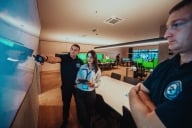You have /5 articles left.
Sign up for a free account or log in.
Donkey’s derriere + shopping cart + tiny bicycle + money tree = access to college. How’s that for some unconventional calculus?
Students checking out a new Web site designed to guide them through the college application process will see these images, each of which corresponds to a step along the way.
Follow closely. The pin sticking into the donkey's rear illustrates step one: “Be a pain” (let everyone know you’re going to college and need help getting there). The student pushing his mirror image in a shopping cart stands for “Push yourself.” The tiny bicycle, with an ill-suited older rider, represents “Find the right [college] fit.” And the tree with dangling green equals “Get your hands on some [financial aid] money.”
“Four steps could sound complicated or intimidating, so we went out of our way to be simple, casual, maybe even a bit playful,” said Bertrand Garbassi of Publicis NY, the ad agency that developed higher education’s latest public service campaign.
The Lumina Foundation for Education, the American Council on Education and the Ad Council are partners in this multimedia effort, which is designed to arm low-income, first-generation students in grades 8 through 10 with information on how to get into college. The billboards, posters, and radio and television spots all direct people to the Web site, www.knowhow2go.com, which officially launches today.
The site shows students how to apply for financial aid, where to find information on colleges and when to begin soliciting help from teachers. It explains concepts such as sticker price and gives parents advice on how to talk to their students about the application process.
Higher education groups have run individual campaigns in recent years with the intention of narrowing the access gap. But none can match the financial muscle of this project, which amounts to $30 million worth of media exposure (all donated). Lumina is giving $3 million to the campaign.
"This is the biggest unified effort that's ever been undertaken" on the issue of college access, said Tim McDonough, a spokesman at ACE.
Martha D. Lamkin, president and chief executive of Lumina, said the campaign is coming at a critical time, when more and more low-income students are thinking about college and needing a centralized resource.
One indication that there's widespread interest in this campaign issue: The Ad Council, which brought you such service campaigns as "A Mind is a Terrible Thing to Waste," and "McGruff the Crime Dog," and which receives far more requests from groups each year than it can accommodate, sought out ACE about working together on the project. Heidi Arthur, a senior vice president at the council, said the higher education community identified the access gap as a topic worthy of a major campaign.
"We need a national voice to this issue," Arthur said. "You don't have to tell kids college is a good thing. But there's a gross misperception about the (application) process. If kids don't know what they need to do and if parents don't understand that there are resources out there, it makes the effort far more challenging."
One objective of the campaign is to get the attention of adults -- coaches, mentors, church leaders --who aren't typically involved in students' push toward college. The YMCA has signed on to put up posters and notify young patrons. Six states have agreed to "localize" the issues in the campaign. And ACE is asking member colleges to advertise the new site on its campuses.
The U.S. Department of Education is printing 500,000 copies of a brochure of college preparation tips and has set up a hotline (800-433-3243) for students and parents with federal student aid questions. There's even a rap song meant for radio stations that was written for the campaign, which runs through December 2008.
"It’s important to measure effectiveness up front, and the idea of two or three years is a minimum,” said Arthur of the Ad Council.
To measure progress, the Ad Council will be conducting a benchmark survey a few months in to gauge the audience. ACE will also monitor how many people have signed up on their Web site to be a part of the campaign.
The public service announcements are being distributed to 28,000 media stations throughout January, according to Melanie Corrigan, the project director for ACE. Networks have a number of television spots from which to choose, each of which features a student who tosses a paper airplane off a skyscraper and an adult who catches it and sees a message that the student wants help getting into college.
"We wanted to capture the dreams of students, and the idea of using a sky full of paper airplanes made sense as a metaphor," said Garbassi of the Ad Council.








